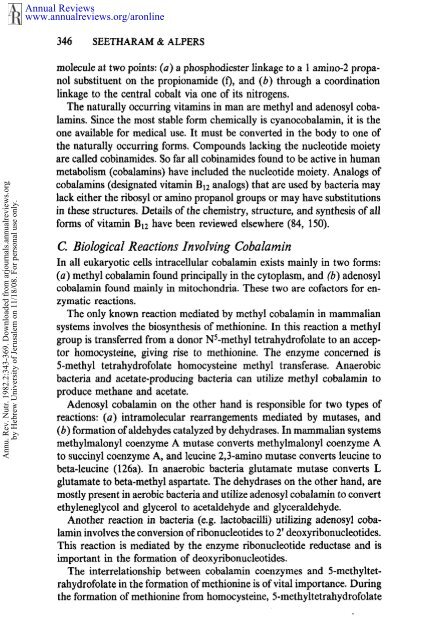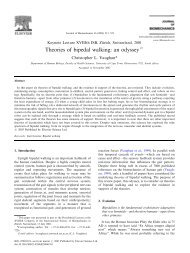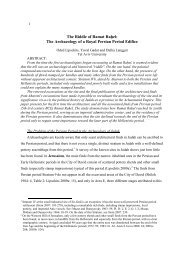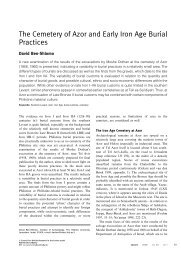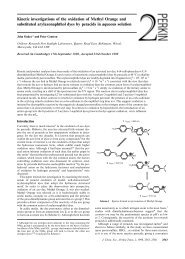Absorption and Transport of Cobalamin (Vitamin B12)
Absorption and Transport of Cobalamin (Vitamin B12)
Absorption and Transport of Cobalamin (Vitamin B12)
Create successful ePaper yourself
Turn your PDF publications into a flip-book with our unique Google optimized e-Paper software.
Annual Reviewswww.annualreviews.org/aronline346 SEETHARAM & ALPERSAnnu. Rev. Nutr. 1982.2:343-369. Downloaded from arjournals.annualreviews.orgby Hebrew University <strong>of</strong> Jerusalem on 11/18/08. For personal use only.molecule at two points: (a) a phosphodiester linkage to a 1 amino-2 propanolsubstituent on the propionamide (f), <strong>and</strong> (b) through a coordinationlinkage to the central cobalt via one <strong>of</strong> its nitrogens.The naturally occurring vitamins in man are methyl <strong>and</strong> adenosyl cobalamins.Since the most stable form chemically is cyanocobalamin, it is theone available for medical use. It must be converted in the body to one <strong>of</strong>the naturally occurring forms, Compounds lacking the nucleotide moietyare called cobinamides. So far all cobinamides found to be active in humanmetabolism (cobalamins) have included the nucleotide moiety. Analogscobalamins (designated vitamin B~2 analogs) that are used by bacteria maylack either the ribosyl or amino propanol groups or may have substitutionsin these structures. Details <strong>of</strong> the chemistry, structure, <strong>and</strong> synthesis <strong>of</strong> allforms <strong>of</strong> vitamin B~2 have been reviewed elsewhere (84, 150).C. Biological Reactions Involving <strong>Cobalamin</strong>In all eukaryotic cells intracellular cobalamin exists mainly in two forms:(a) methyl cobalamin found principally !n the cytoplasm, <strong>and</strong> (b) adenosylcobalamin found mainly in mitochondria. These two are c<strong>of</strong>actors for enzymaticreactions.The only known reaction mediated by methyl cobalamin in mammaliansystems involves the biosynthesis <strong>of</strong> methionine. In this reaction a methylgroup is transferred from a donor NS-methyl tetrahydr<strong>of</strong>olate to an acceptorhomocysteine, giving rise to methionine. The enzyme concerned is5-methyl tetrahydr<strong>of</strong>olate homocysteine methyl transferase. Anaerobicbacteria <strong>and</strong> acetate-producing bacteria can utilize methyl cobalamin toproduce methane <strong>and</strong> acetate.Adenosyl cobalamin on the other h<strong>and</strong> is responsible for two types <strong>of</strong>reactions: (a) intramolecular rearrangements mediated by mutases, <strong>and</strong>(b) formation <strong>of</strong> aldehydes catalyzed by dehydrases. In mammalian systemsmethylmalonyl coenzyme A mutase converts methylmalonyl coenzyme Ato succinyl coenzyme A, <strong>and</strong> leucine 2,3-amino mutase converts leucine tobeta-leucine (126a). In anaerobic bacteria glutamate mutase convertsglutamate to beta-methyl aspartate. The dehydrases on the other h<strong>and</strong>, aremostly present in aerobic bacteria <strong>and</strong> utilize adenosyl cobalamin to convertethyleneglycol <strong>and</strong> glycerol to acetaldehyde <strong>and</strong> glyceraldehyde.Anothereaction in bacteria (e.g. lactobacilli) utilizing adenosyl cobalamininvolves the conversion <strong>of</strong> ribonucleotides to 2’ deoxyribonucleotides.This reaction is mediated by the enzyme ribonucleotide reductase <strong>and</strong> isimportant in the formation <strong>of</strong> deoxyribonucleotides.The interrelationship between cobalamin coenzymes <strong>and</strong> 5-methyltetrahydr<strong>of</strong>olatein the formation <strong>of</strong> methionine is <strong>of</strong> vital importance. Duringthe formation <strong>of</strong> methionine from homocysteine, 5-methyltetrahydr<strong>of</strong>olate


